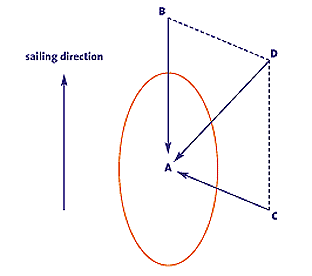| |
 |

Sailing a Square Rigged Ship
Understanding forces
The forces acting on a sail that move a ship through the water would make an interesting subject for a student research paper and class presentation. To get them started, you might share the following excerpt from a lesson on the subject taught by Leon Kaufman and based on Eagle Seaman-ship, A Manual for Square Rigger Sailing: revised by Paul M. Regan, LCDR, USCG U.S. Naval Institute Press, Annapolis MD, 1979.
The wind that strikes the sails is not the true wind but a relative wind, a combination of the true wind and a wind vector produced by the ship’s motion through the water. As diagramed below, the relative wind is forward of the true wind. The faster the ship moves in relation to the true wind, the farther forward the relative wind. The sails are always trimmed to this relative wind rather than the true wind.  |
| AB | Motion of the ship creates a wind directly opposite to the direction of the ship’s motion and equal to its speed. | | AC | The true wind | | AD | The resultant relative wind experienced on board which strikes the sail. The stronger the wind AB, the farther forward will be the resultant relative wind AD. | to top
|
 |





